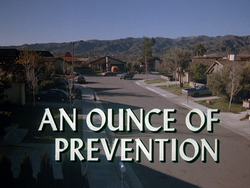An Ounce of Prevention (Quincy, M.E.)
| An Ounce of Prevention | ||||||||||||||||||||||||||||||||||||||
|---|---|---|---|---|---|---|---|---|---|---|---|---|---|---|---|---|---|---|---|---|---|---|---|---|---|---|---|---|---|---|---|---|---|---|---|---|---|---|

| ||||||||||||||||||||||||||||||||||||||
|
Episode Quote
"How many people have to die before we start preventing fires instead of just cleaning up after them?" ~ Dr. Quincy
Episode Overview
An Ounce of Prevention (Season 3, Episode 16) aired on NBC on **February 15, 1979**. Quincy investigates a deadly fire that killed several elderly tenants in a residential building with poor safety infrastructure. As the autopsy reveals all victims died from preventable smoke inhalation, Quincy shifts focus from individual pathology to systemic negligence—pushing for improved fire codes and enforcement, even as city officials push back.
Application of The QME Episode Laws
This episode powerfully exemplifies the four **QME Episode Laws**:
✅ **Law 1 – Seek truth and bring justice:** Quincy refuses to accept the deaths as unavoidable and investigates deeper into the building’s safety failings. ✅ **Law 2 – Explore social and ethical issues:** The episode addresses substandard housing, code enforcement failures, and the devaluation of elderly lives. ✅ **Law 3 – Tackle sensitive topics respectfully:** It handles aging, poverty, and civic responsibility with empathy and urgency. ✅ **Law 4 – Maintain forensic accuracy:** The autopsies include lung tissue analysis, carbon monoxide levels, and evidence of delayed fire response.
Episode Synopsis
A fire in a low-income apartment building leaves several dead, including elderly residents who couldn't escape in time. Quincy performs autopsies confirming death by smoke inhalation and thermal injury, but finds signs the fire was accelerated by faulty wiring and poor building maintenance. He confronts city housing authorities, presses for code reforms, and allies with Dr. Evelyn Stewart, a public health advocate, to push for fire prevention measures that prioritize vulnerable populations.
Case File Summary
Victims: Elderly tenants of Sandpiper Apartments – death by smoke inhalation. Case #: QME 3.16 / 51093
Cause of death: Hypoxia due to carbon monoxide poisoning; no evidence of foul play, but systemic negligence implicated.
Alleged Perpetrator(s) & Additional Victims
- Additional victims: Other tenants exposed to unsafe living conditions.
- Alleged perpetrator(s): Property owners and city inspectors accused of ignoring fire hazards and neglecting code compliance.
Forensic Science Insight
- Carbon monoxide saturation levels recorded at 72–88% in fatal cases.
- Post-mortem signs of heat-related lung hemorrhaging.
- Fire pattern analysis revealed accelerated burn path linked to non-compliant wiring.
Themes & Tropes
- **Neglect of the elderly** – society’s failure to protect its most vulnerable citizens.
- **Preventive pathology** – Quincy as advocate for structural change, not just cause-of-death diagnosis.
- **Science vs politics** – bureaucracy and liability fears clash with public health urgency.
- **“If it saves one life…” argument** – policy change as the ultimate goal of forensic investigation.
Reception & Ratings
IMDb rating: **7.4/10** (987 votes)—praised for its realism and civic urgency, though some critics found the reform subplot slightly didactic. :contentReference[oaicite:11]{index=11}
Trivia
- Anne Schedeen, who guest stars as Dr. Stewart, would later star in *ALF* (1986–1990).
- The episode inspired local fire prevention campaigns in several cities, including Los Angeles and Chicago, after its original airing. :contentReference[oaicite:12]{index=12}
Cultural Impact
An Ounce of Prevention became a standout example of how *Quincy, M.E.* used procedural drama to spur real-world policy debate. Its focus on fire code enforcement prefigured national safety campaigns in the 1980s.
See Also
- Walk Softly Through the Night – Part II (Quincy, M.E.)
- The Law Is a Fool (Quincy, M.E.)
- List of Quincy, M.E. episodes
- QME Ep Laws
- Fire safety
- Public health advocacy
